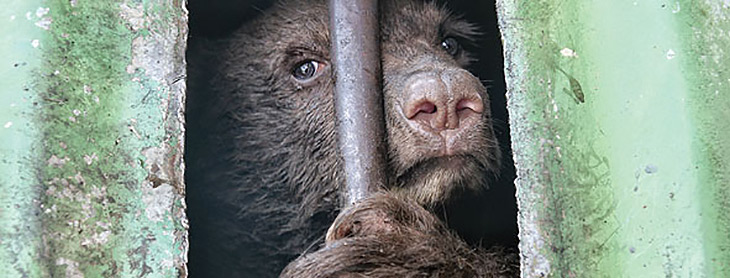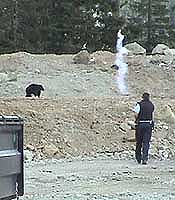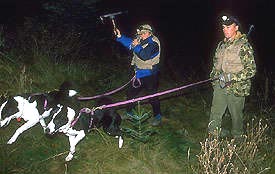
Aversive conditioning of bears has been used as an effective management tool to resolve human-bear conflicts since the early 1970s. It was first developed and applied in the national parks of Canada and the United States. Over time, “traditional” aversive conditioning has evolved into bear aversion using improved methodologies and tools. Non-lethal bear management combines bear aversion with proactive bear management strategies such as effective waste management, education and enforcement to provide a more holistic approach.
Bear aversion uses negative conditioning to modify undesirable bear behaviour so the animals don’t need to be killed. By demonstrating human dominance through body posture and voice control, wildlife managers begin to communicate in ways bears will understand. This allows officers to command the bears’ respect and re-instill their natural wariness of humans. Non-lethal tools, such as rubber bullets, pyrotechnics and bear spray, are used to reinforce this message.
 This type of conditioning makes use of the bear’s ability to learn from negative and positive experiences. Whenever a bear exhibits undesirable behaviour, such as approaching people or developed areas, a negative experience is delivered to the animal. The objective is for the bear to react appropriately by leaving. The bear then learns to associate undesirable behaviour with a negative experience, and will be more likely to avoid conflict in the future.
This type of conditioning makes use of the bear’s ability to learn from negative and positive experiences. Whenever a bear exhibits undesirable behaviour, such as approaching people or developed areas, a negative experience is delivered to the animal. The objective is for the bear to react appropriately by leaving. The bear then learns to associate undesirable behaviour with a negative experience, and will be more likely to avoid conflict in the future.
Urban wildlife can be taught that certain behaviours are unwanted and will not be tolerated by people. The bear aversion program establishes boundaries that bears can be taught to respect, a trait some bears have lost over time through poor management strategies and a generally submissive reaction by humans. We have baited bears with a food reward into human settlement areas and then punished them with death for accepting an easy meal.
Communities need to decide their level of tolerance toward bears and establish a clear set of rules that are consistently enforced – every time a bear crosses the line, it must be taught to respect the rules through negative conditioning. This method, which capitalizes on the bear’s innate tendency to avoid conflict and fit into the natural dominance hierarchy, doesn’t harm bears and teaches them to stay away from people and their property. (See the section on bear behavior.)
This approach has met with success in Mammoth Lakes (CA), Yosemite National Park (CA), Kananaskis Country (AB), and Whistler (BC), where the number of human-bear conflicts has dropped significantly. As a result, there has been a notable reduction in the number of bears that are destroyed and relocated, and considerably fewer resources are required to deal with conflict situations.
Great Smoky’s Kim Delozier once went undercover to send a message to a bear that had learned if it charged hikers, they dropped their packs and ran off. He traded his park uniform for hiking gear and hit the trail. When the 260-ound bear spotted Delozier, it launched itself at the biologist in a blur of flying fur, clacking teeth and popping jaws. Much to the bear’s surprise, Delozier practiced the advice he preaches and stood his ground. When no pack full of treats went flying through the air, a confused bear hit the breaks and slid to a stop at Delozier’s feet. – Linda Masterson in Living with Bears (pg 210)
Currently, bear aversion techniques are being used as part of bear management programs in many other areas, including British Columbia, Ontario, California, Louisiana, New York, New Jersey, Michigan and Maryland. National parks in both Canada and the United States also have used Conditioned Taste Aversion (CTA), as well as noise and physical deterrents on bears.
The advantages of bear aversion over the more traditional methods of relocation and destruction are clearly apparent. Relocating so-called “problem” bears is not an effective solution [Landriault 1998). Relocated bears also experience considerable stress when relocated, to the extent that it can affect their survival. They can have trouble locating new food sources, secure habitat, and bedding and denning sites within the release area. Competition with resident bears in the new area may lead to injury or death inflicted by more dominant bears in or near the release area. The bears that do survive often become a problem in or near the release area, or they return to their original territory where they continue to be in conflict. (Kansas et al. 1989; Heuer 1993; Ciarniello 1996). Click here for more information on relocation.
Destroying bears is not an effective solution either. By removing a “problem” bear, an opportunity is created for another bear to move into the newly available habitat niche. Consequently, the problem is not solved, and wildlife officials commit to a perpetual cycle of killing bears, public outrage and negative press.
 It is imperative to keep an open mind and consider new alternatives. Bear aversion can be an ethical, cost-effective method of reducing bear mortality and enhancing public safety and property damage. Once a community has invested in “training” the resident bear population to a manageable degree, only occasional retraining reminders are required.
It is imperative to keep an open mind and consider new alternatives. Bear aversion can be an ethical, cost-effective method of reducing bear mortality and enhancing public safety and property damage. Once a community has invested in “training” the resident bear population to a manageable degree, only occasional retraining reminders are required.
However, it must be stressed that non-lethal bear management should be seen as an aid, not a substitute for preventive measures that eliminate or reduce the potential for human-bear conflicts. Bear aversion is most effective when bear attractants (such garbage, pet food and bird feeders) are secured from bears. The use of repellents and deterrents should be considered a second line of defense against bear problems.
For more information, please download a copy of Responding to Human-Black Bear Conflicts: A Guide to Non-lethal Bear Management Techniques.Download Management Action Chart.
It’s not a silver bullet, but it is silver buckshot!
